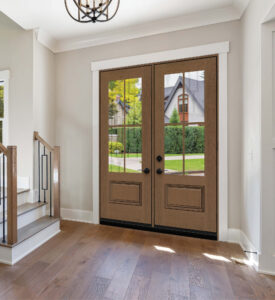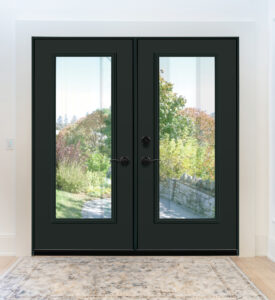
256 Lombard St., Smiths Falls, ON K7A 0B5

admin@smwindowsanddoors.ca

256 Lombard St., Smiths Falls, ON K7A 0B5

admin@smwindowsanddoors.ca
High-Performance Windows & Doors – Professionally Installed!
Energy-efficient, clean craftsmanship, no shortcuts



Fibreglass doors are made of a composite material with a fiberglass skin, a foam core for insulation, and a frame, often made of wood or composite, offering durability, weather resistance, and the ability to mimic wood grain for a low-maintenance, high-impact look.
Construction
Core: Fiberglass doors feature a foam core, typically made of polyurethane foam, which provides insulation and soundproofing.
Fiberglass Skin: The outer layer is a compression-molded fiberglass skin, which is resistant to dents, scuffs, and cracking.
Frame: The door frame is often made of wood or a composite material.
Key Features and Benefits
Weather Resistance: Fiberglass doors are highly resistant to moisture, extreme temperatures, and other weather conditions, making them suitable for various climates.
Low Maintenance: Unlike wood doors, fiberglass doors don’t warp, rot, or crack, reducing maintenance needs.
Durability: Fiberglass is a strong and durable material that can withstand daily use and environmental conditions.
Energy Efficiency: The foam core and durable construction contribute to better insulation and energy efficiency.
Aesthetics: Fiberglass doors come in various styles and can be designed to look like wood, with realistic wood grain textures and finishes.
Variety of Options: Fiberglaas doors can be customized with different styles, hardware, glass panels and finishes.
Steel doors offer robust security, durability, and can be energy-efficient, making them a practical and attractive choice for various applications, available in residential, commercial, and industrial settings.
Strength and Security:
Steel’s inherent strength provides excellent protection against forced entry and impacts.
Durability and Longevity:
Steel doors are highly durable and resistant to weather, warping, and cracking, ensuring long-lasting performance.
Low-Maintenance:
Steel doors require minimal upkeep, resisting rust and corrosion, making them easy to maintain.
Variety of Styles and Configurations:
Steel doors come in various styles and configurations to match different aesthetic preferences and architectural needs.
Energy Efficiency:
Some steel doors can be certified as energy-efficient, helping to reduce energy costs
Variety of Applications:
Suitable for residential, commercial, and industrial settings, including fire-rated applications.
Recyclable:
Steel is infinitely recyclable, making it an environmentally friendly choice.
Sound Reduction:
Steel doors can also offer sound reduction, which can be beneficial in noisy areas.
Hygienic:
Steel doors can be made corrosion-resistant and hygienic, suitable for facilities like food and beverage facilities.
Examples of steel door applications:
Residential Entry Doors:
A popular choice for front doors due to their security and durability.
Commercial Buildings:
Steel doors are used in offices, hospitals, and other commercial facilities for their strength and security.
Industrial Applications:
They are used in warehouses, factories, and other industrial settings for their durability and weather resistance.
Fire Rated Doors:
Steel doors can be designed for fire resistance, helping to contain the spread of fire.
Patio doors, also known as sliding glass doors, are a type of large door typically used to connect indoor and outdoor spaces, often featuring large glass panels that slide horizontally along a track for easy access and maximized natural light.
Function: Patio doors are designed to create a seamless transition between indoor and outdoor spaces, allowing easy access to patios, decks, gardens, or other outdoor areas.
Construction: Glass: Typically made of large glass panels for optimal light transmission and views.
Frame: The glass panels are supported by a frame, which can be made of wood, vinyl, aluminum, or fiberglass, offering structural integrity and insulation.
Types:
Sliding Patio Doors: These doors consist of panels that slide horizontally, offering a space-saving and sleek design.
French Doors (also known as swinging patio doors): Feature two panels that swing open outwards, offering a charming and traditional appeal.
Multi-slide patio doors: feature multiple panels that slide open easily and intuitively, stacking against each other or tucking away out of sight into a wall pocket.
Benefits:
Openness and Light: Maximize natural light and create an open, airy feel in your home.
Unobstructed Views: Enjoy panoramic views of your outdoor space.
Easy Access: Provide convenient and easy access to outdoor areas.
Space-Saving: Sliding doors are a space-saving option, especially when compared to traditional swinging doors.
Common Configurations:
Two-panel sliding doors are common.
Some doors have three or four panels.
Multi-slide doors feature multiple panels that slide open easily and intuitively, stacking against each other or tucking away out of sight into a wall pocket.
Other Features:
Patio doors are often designed with slim frames to maximize glass area and views.
Some patio doors feature a twin locking system for added security.
Considerations:
Energy Efficiency: Choose patio doors with good insulation properties to prevent heat loss in winter and heat gain in summer.
Style and Design: Patio doors come in various styles, from contemporary to traditional, so you can choose a design that complements your home’s aesthetic.
Material: Consider the pros and cons of different frame materials (wood, vinyl, aluminum) in terms of durability, maintenance, and cost.
Weather Resistance: Make sure to consider the weather conditions in your area when choosing patio doors.